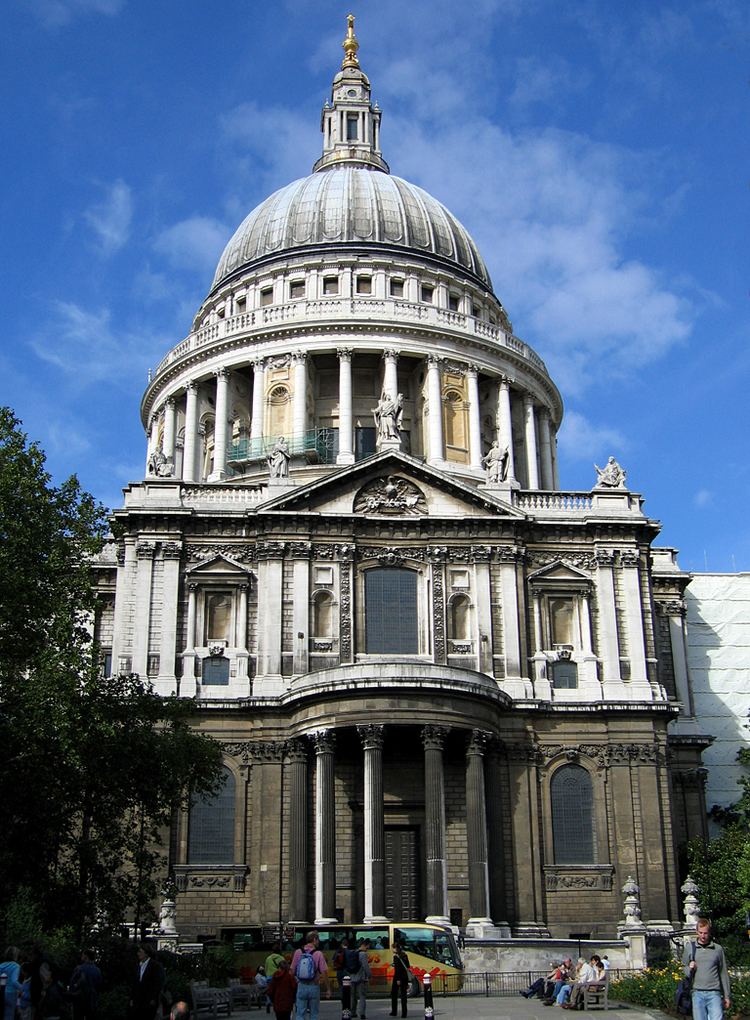 | ||
London is the location of many famous churches, chapels and cathedrals, in a density unmatched anywhere else in England.
Contents
Wren and Anglican churches
Before the Great Fire of London in 1666, the City of London had around 100 churches in an area of only one square mile (2.6 km2). Of the 86 destroyed by the Fire, 51 were rebuilt along with St Paul's Cathedral. The majority have traditionally been regarded as the work of Sir Christopher Wren, but although their rebuilding was entrusted primarily to him, the role of his various associates, including Robert Hooke and Nicholas Hawksmoor especially, is currently being reassessed and given greater emphasis.
With regard to Anglican churches, as opposed to Catholic churches, nonconformist chapels or meeting houses, the designs of the Wren office provided a new standard for British church architecture ever since, as well as giving a distinctive face to the Anglican church in London. Wren also designed a number of Anglican churches outside the City, including St James's, Piccadilly and St Clement Danes. After the Wren era, Hawksmoor was responsible for six of the great Anglican churches in the East End of London (for example Christ Church, Spitalfields), and other architects such as Hooke, James Gibbs and John James contributed significantly to Anglican church architecture in London.
Metropolitan area
London's churches and chapels are extraordinarily numerous and diverse. Anglican and nonconformist churches and chapels are most numerous, but there are also many Catholic churches as well as places of worship for non-Christian religions.
Most of the Anglican churches lie within the Anglican dioceses of London to the north and Southwark to the south. For historical reasons, the Anglican churches in London north of the Thames but east of the River Lea fall within the Diocese of Chelmsford, and those in the London Boroughs of Bexley and Bromley fall within the Diocese of Rochester. A few Anglican churches in the Barnet area fall into the Diocese of St Albans, reflecting the historical association of Barnet with Hertfordshire. The Catholic dioceses that cover Greater London are, north of the Thames and west of the Lea, the Diocese of Westminster; south of the Thames the Archdiocese of Southwark; and north of the Thames and east of the Lea, the Diocese of Brentwood. There are still some two thousand Anglican churches alone, across the capital and if nonconformist and other denominations are included, they cover every age and style, in the design and evolution of which at least six hundred different architects have made contributions. As London expanded during the early 19th century, many new churches and chapels were built independently by the growing nonconformist urban population; to match the growth in nonconformist churches and chapels, the Anglican "Waterloo church" building programme saw numerous Anglican churches constructed across south London in the first half of the century.
Significance
Although many churches and chapels were entirely or partly lost to 19th-century demolitions and to bombing in the Second World War, many historic, architecturally significant and religiously significant buildings remain, particularly in the City of London and the neighbouring City of Westminster. A number of the churches are mentioned in the nursery rhyme Oranges and Lemons. Churches in this list belong to various denominations, as indicated.
In London boroughs
Greater London is divided into 32 London boroughs, and the City of London – the ancient core and financial centre. While there is evidently an innumerable and ever increasing number of new Pentecostal, independent and ethnic diaspora churches in London, mostly meeting in temporary venues, this list is intended to include many of the more permanent churches and buildings which identify themselves as a place of Christian worship. The denominations appended are those by which they self-identify.
City of London
The City of London is not a London borough, but while being a ceremonial county in its own right, is within Greater London. In 1666 there were 96 parishes within the bounds of the City. Today the following continue Christian witness in one form or another in the heart of London.
Non-English speaking churches
There are many examples throughout London (central and suburban) of English-speaking churches which also provide regular worship in one or more secondary languages, particularly amongst the Anglican and Roman Catholic churches. Numerous English-speaking Roman Catholic churches in London provide worship in assorted non-English languages, including Arabic, Cantonese, Aramaic, French, German, Italian, Korean, Latin, Lithuanian, Polish, Portuguese (including Brazilian Portuguese), Romanian, Slovak, Spanish, Syriac, Tamil and Tigrinya.
The following table lists churches which conduct their worship in modern languages other than English, or English-speaking churches which have notable non-Anglophone congregations based in the same building.
